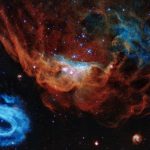When stars collide: Solving the 16-year mystery of the Blue Ring Nebula0
- From Around the Web, Space
- November 19, 2020
Two stars merged, spewing out debris in opposite directions to form two glowing cones

Two stars merged, spewing out debris in opposite directions to form two glowing cones

A report delivered new HD images from the Gemini South telescope in Chile showing the birth of a star.

Thousands of light years away, there’s a “space butterfly” colored with brilliant blues and clouds of purple and red. It’s an image we’ve never seen in this much detail before.

Two bright nebulas in a galaxy 163,000 light-years away are very pregnant with stars.

According to new research, a nearby binary neutron-star merger gave birth to 0.3% of the Earth’s heaviest elements, including gold, platinum and uranium; such an event may have occurred about 1,000 light-years away from the Pre-solar Nebula, approximately 80 million years before the formation of our Solar System.

Happy Valentine’s Day… from space!

NASA inspects these “Kitchen Smoke” Molecules in the Nebula to get an idea on how life started.

Space is beautiful. These are nine images of the most beautiful sights we have of space that people have taken pictures of.

We now have a better idea of what nebulae looks like now that scientists have worked out a 3D model of one of them.

The star at the center of the Red Rectangle is similar to Earth’s sun and is responsible for those evenly spaced lines as it releases gas and other material to create the nebula and its distinctive shape.